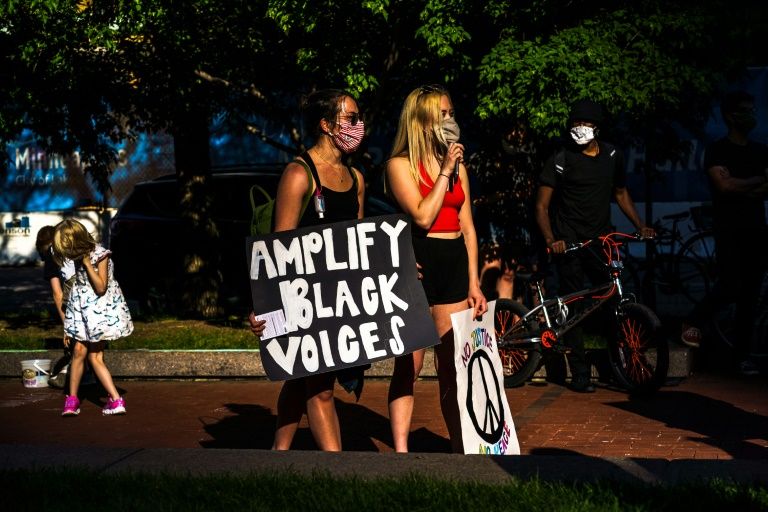Anti-racism protest coverage sparks reckoning across US newsrooms
()
Many black journalists have been tweeting about their personal work experiences, decrying the challenges of navigating an industry that’s long been dominated by white men. ©AFP/File Kerem Yucel
Anti-racism protests triggered worldwide after the police killing of George Floyd have many American newsrooms grappling with their own role in contributing to racial inequity.
The past week has seen a widespread backlash and a slew of resignations, both over Black Lives Matter protest coverage and mushrooming accusations that reporters of color face chronic mistreatment at a number of top US media organizations.
The New York Times opinion page editor resigned in flames after publishing a hardline column by a US senator who urged military force against protestors, as the Philadelphia Inquirer’s news head also stepped down following blowback for the headline “Buildings Matter, Too,” in reference to the damage caused by violence at the demonstrations.
And the editor-in-chief of Bon Appetit, a culinary magazine owned by media powerhouse Conde Nast, left in disgrace over accusations he belittled and underpaid employees of color as a photo of him wearing brownface circulated online.
Similar situations rippled across the industry, from lifestyle websites to newspapers, as outlets organized employee town halls and scrambled to issue statements of solidarity, apologies and vows to improve.
Many black journalists meanwhile began tweeting about their personal work experiences, decrying the challenges of navigating an industry that’s long been dominated by white men.
“is anyone else the only black reporter in their newsroom?” tweeted Akela Lacy, who covers politics at The Intercept.
The 27-year-old, who began reporting for the left-leaning investigative publication after working at Politico, told AFP that while most people within news organizations are well-intentioned, the industry “can foster a culture that is hostile to non-white people.”
Martin Reynolds — co-head of the Maynard Institute, a body focused on promoting diversity in news media — argued that mainstream legacy journalism institutions were “largely complicit in perpetuating structures of institutional racism, because we haven’t explicitly challenged them.”
The former editor-in-chief of The Oakland Tribune also pointed to the lack of newsroom diversity as inextricably linked to the question of well-rounded coverage.
Some 77 percent of American newsroom employees are non-Hispanic whites, according to 2018 data from the Pew Research Center — compared to 65 percent of all US workers, and 60 percent of the overall population. Non-Hispanic white men make up almost half of newsroom employees.
Inadequate diversity can prove particularly problematic on a day-to-day basis, said Ken Paulson, former editor-in-chief of USA Today, as outlets often fail to adequately cover communities of color until there’s a scandal or violence.
“Big stories always get the attention,” he said. “The challenge is to tell the smaller stories that paint a picture of what’s actually happening. Journalists and diversity are key to that.”
Many black journalists, Reynolds said, have reached their breaking point.
“There’s a parallel uprising in communities and uprising in a lot of newsrooms that is beginning to amplify,” he said.
– ‘Systematically racist system’ –
The Pittsburgh Post-Gazette came under fire this week for barring a black woman reporter from covering protests after she posted a personal tweet regarding property damage linked to demonstrations — which the outlet considered compromising to her ability to remain objective.
Facing an uproar, the company’s executive editor cited “a longstanding canon of journalism ethics” that prevents voicing opinion about topics of coverage.
But the journalist at the row’s center, Alexis Johnson, held that she was singled out for tweeting about a “black issue.”
Reynolds questioned the paper’s logic, calling the notion of objectivity a “fallacy” and saying the responsibility lies instead in fairness, which requires personal bias awareness.
Lacy, at The Intercept, voiced a similar point, citing “a huge hesitancy to take non-white reporters and staff’s word as unbiased” as endemic to many newsrooms.
That editorial framework, she said, has shaped coverage to conform to a narrative that’s overwhelmingly white-centric.
“It’s unnerving for a lot of us to see the benefit of the doubt continuously given to the people who have written the rule,” she said.
“There’s some things that you look at and you’re like, either no black person looked at this, or y’all just didn’t listen to what they have to say.”
Both Lacy and Reynolds voiced hope that the difficult conversations launching in some newsrooms indicated hope for a more just, equitable future of news.
“Imagine what kind of country and world we can have if we address these systemic issues that are imperiling people of color, and at the same time focus on our journalism institutions so that they can better reflect the diversity of the country and world — to stop being a sustainer of a systematically racist system,” Reynolds said.
Maggy Donaldson and Thomas Urbain
(AFP)
Disclaimer: Validity of the above story is for 7 Days from original date of publishing. Source: AFP.


